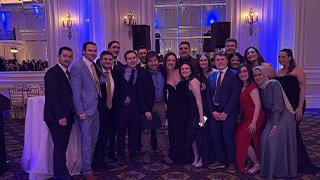Survey Offers New Insights into How Gen Z View Leadership and What They Expect From Future Employers
Thursday, September 23, 2021

The results of the Future of Leadership Survey: 2021 are in. More than 900 Seton Hall University students and recent alumni — members of the Gen Z emerging workforce — reveal several notable shifts in the future of leadership from broadly perceived norms. Responses to The Future of Leadership Survey: 2021, research designed by faculty in the Buccino Leadership Institute, indicate: a shift toward acceptance of diversity in the ranks of future leaders; that perception of the most influential leaders in their formative years — someone at home or at school — does not appear to be predictive of their perception of the persona of a mid-level leader in the workplace; and an increased desire for engagement from employers — whether it is in dealing more effectively with crisis and failure, in preventing worker alienation, or in managing work-life balance.
The survey questions focused on respondents' impressions of an outstanding leader, linking their identified leader with specific behaviorally-based reflections about this leader. Then, a series of statements were posed about physical traits of leaders, nested in prior traits research, some of which is over 50 years old. From there, survey questions were constructed to seek respondents' input on important competencies and values of the mid-level leader. These questions were posed to obtain a form of leadership trajectory for young leaders — the competencies and values that would be important in a leadership position they envisioned 10 years or so into their own future, as well as the competencies and values they would be seeking from their own boss. Other questions focused on challenges facing future leaders and how best to develop leaders of tomorrow.
The survey findings, along with analysis by research authors Professors Steven Lorenzet and graduate student Alexander McAuley (all from the Stillman School of Business), are explored at length in the latest edition of In the Lead, a magazine that addresses the topic of leadership, with a focus on sharing leadership perspectives from the field.
Among the key findings:
Growing up, Mom is the most influential leader
Survey respondents were asked to identify the most influential leader thus far in their life, someone they had observed personally, and to rate behaviors to determine the personality traits of these leaders.
- 55% of survey respondents identified a parent, and another 9% identified a family member (grandparents, siblings, cousins) or friend as the most influential leader in their life.
- 29% of respondents identified a professor, teacher, or coach as the most influential leader in their life, and the other 3% were bosses or co-workers.
- Overall, mom emerges as the most influential leader—identified by 27% of the target respondents.
- When asked about the observed personality traits of these most influential leaders, extraversion, agreeableness and conscientiousness were ranked as high, and emotional stability as moderate.
Physical traits matter less
The researchers sought to understand the current generation's views on the relevance of physical traits in their perception of a leader and whether physical traits would be less important to respondents—specifically, what leaders do versus how they look. The survey respondents were presented with six predominantly studied physical traits— attire, attractiveness, deep voice, hair, health, height and physical fitness—and were asked to rate them.
- Unlike respondents from the early studies of trait research, survey respondents did not confirm the importance of most physical traits. They did not place strong emphasis on height, deep voice, physical fitness or attractiveness of the leader. Further, height and deep voice, the two attributes that are genetic, rank the lowest as the attributes of a leader.
- Attire, health and hair are attributes that were most strongly linked with the persona of a leader, with attire ranking the highest.
- According to the researchers, the reduced emphasis on genetic physical traits (e.g., height, deep voice, physical fitness and attractiveness) is indicative of a more inclusive world, where physical traits begin to matter less in one's ability to be seen as a leader.
The Middle Level Leader is adept, collaborative, inclusive, persistent, a good communicator and a problem solver
Survey respondents were asked to pick three competencies and values they would seek if hiring a mid-level manager/leader in their organization.
- The persona of a mid-level manager/leader that emerges from the survey, from a competencies perspective, points to an individual who is "adept at dealing with problems and conflicts," "communicates effectively" and "collaborates with customers and employees." The top three values this individual demonstrates include "adaptive," "seeks diverse perspectives" and is "persistent in the face of failure."
- Values of mentoring and leading with higher purpose seldom made it to the top three. Similarly, the competencies of staying updated on market trends and taking advantage of global opportunities did not come up as a priority for this persona.
- Respondents who reported having at least six months of work experience (36 percent of the dataset) ordered the top three competencies differently versus those with no experience. (Ranking by respondents with experience: "1. deals with problems and conflicts," "2. communicates effectively," and "3. collaborates with customers and employees."; Ranking by respondents with no experience: "1. communicates effectively," "2. collaborates with customers and employees," and "3. deals with problems and conflicts.")
- Respondents who reported as having at least six months of work experience (36 percent of the dataset) ordered the top three values differently. (Ranking by respondents with experience: "1. Seeks diverse perspective," "2. adaptive" and "3. Persists in face of failure;" Ranking by respondents with no experience: "1. adaptive," "2. Seeks diverse perspective" and "3. Persists in face of failure.")
The importance of employee engagement
Responses to questions about the top three challenges facing leaders today point strongly to the need for better employee engagement.
- The respondents identified "dealing with crisis and failure," "managing work-life balance across the organization" and "preventing worker alienation" as being most important.
A preference for high-touch leadership development
The pandemic has led to the development of hybrid learning models and remote work practices. The researchers wanted to see if these models also cross over into preferences for leadership development approaches and suggest a framework that can be utilized for future leadership development.
- The respondents ranked "employer-driven leadership development programs," "job shadowing a leader" and "graduate level leadership development programs" as their top three choices.
- Closely following were "on the job leadership coaching sponsored by the employer" and "undergraduate level leadership development programs."
- "Podcasts" and "online certificates" ranked the lowest, indicating a preference for high-touch leadership development models.
"Our findings indicate that, according to this snapshot of today's emerging workforce, the discipline of leadership is evolving," said Kansal, lead author of the research, former Chief Strategy and Transformation Officer and Instructor in the Department of Management in the Stillman School of Business. "The future of leadership embraces diversity, believes leaders can be developed and expects leaders to have strong people and engagement skills. Combining these attributes with high-touch leadership development models can unleash a future generation of leaders that will shape our future. Borrowing from the world of mathematics, these future leaders are like vectors—with their own magnitude (intensity of training and development) and direction (values and competencies)—and they will become leaders in their own right."
"What is powerful to observe is that, regardless of the generation, and regardless of how the nature of work has changed over time, individuals still value the importance of the intrinsic value of what they do at work," said Dr. Boroff, professor and dean emeritus. "Leaders must continue to strive to design work and structure positions where it is clear that employees see the value in investing their best in what they do."
"Organizations have interesting decisions to make when it comes to developing the next generation of leaders," added Dr. Lorenzet, associate dean and associate professor of management. "They will have to consider what content to include and where to send future leaders for developmental experiences. Our findings suggest there is room for industry-academic partnership with leadership competencies being developed through experiences in both settings. The opportunity exists for academic institutions and companies to collaborate to make a meaningful impact on the future of leadership."
For more on the survey results, read the latest edition of In the Lead magazine.
Categories: Business





